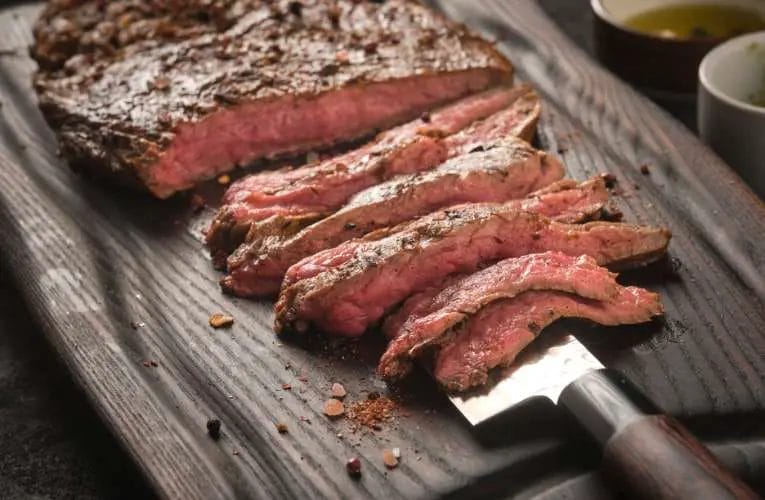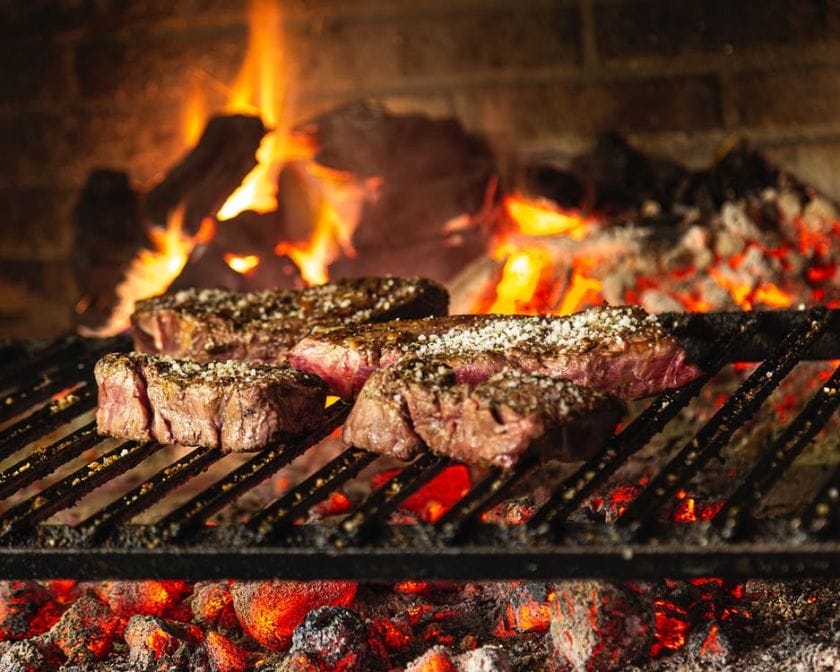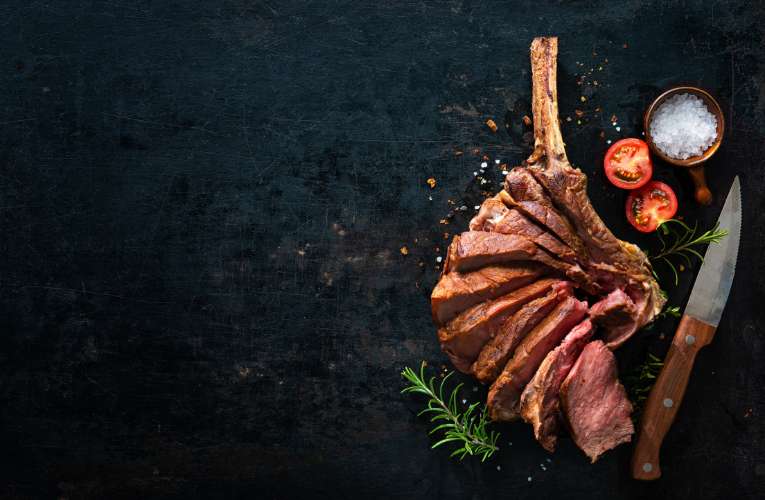Dry aged steak is a delicacy that offers a unique and intense flavor profile. While the cooking process for dry aged steak is similar to regular steak, there are a few key differences to keep in mind.
The extended aging process results in a denser and more concentrated meat, which requires proper handling and cooking techniques for optimal results.
One important factor to consider when cooking dry aged steak is the reduced moisture content. The aging process causes the steak to lose moisture, making it more susceptible to overcooking. It is crucial to monitor the cooking time and temperature closely to avoid drying out the meat.
Additionally, the intense flavor of dry aged steak pairs well with simple seasonings. A sprinkle of salt and pepper are often enough to enhance the natural flavors without overpowering them. It’s best to let the quality of the meat shine through rather than masking it with heavy marinades or sauces.
Whether you choose to grill, pan-sear, or broil your dry aged steak, achieving the perfect level of doneness is key.
The reduced moisture content can result in a quicker cooking time, so it’s essential to keep a close eye on the steak to avoid overcooking. Use a meat thermometer to ensure that the internal temperature reaches your desired level of doneness.

Benefits of Cooking Dry-Aged Steak
When it comes to cooking steak, there are many techniques and methods to choose from. One method that has gained popularity among steak enthusiasts is cooking dry-aged steak.
Dry-aging is a process that involves aging the steak in a controlled environment (usually a refrigerator) for several weeks. This process allows the meat to develop a more intense flavor and tender texture.
In this section, we will explore the benefits of cooking dry-aged steak.
1. Enhanced Flavor
Dry-aging enhances the flavor of steak by allowing the natural enzymes in the meat to break down the muscle tissues. This breakdown process results in a more concentrated and complex flavor profile.
Dry-aged steak is often described as having a rich, nutty, and even slightly sweet taste. The longer the steak is aged, the more pronounced the flavor becomes.
2. Increased Tenderness
In addition to enhancing the flavor, dry-aging also improves the tenderness of the steak. During the aging process, the connective tissues in the meat break down, resulting in a more tender texture. This makes the steak easier to chew and gives it a melt-in-your-mouth quality that is highly sought after.
3. Unique Texture
Dry-aged steak has a unique texture that sets it apart from fresh or wet-aged steak. The aging process causes the moisture in the meat to evaporate, which creates a more concentrated and firm texture. This unique texture is often described as buttery and velvety, providing a truly indulgent dining experience.
4. Intensified Aroma
One of the distinctive characteristics of dry-aged steak is its intensified aroma. The aging process allows the meat to develop a complex blend of aromas that can be detected even before taking the first bite.
The aroma of dry-aged steak is often described as earthy, nutty, and slightly funky, adding another layer of sensory pleasure to the dining experience.
5. Customizability
When cooking dry-aged steak, you have the flexibility to customize the level of aging to suit your personal preferences. The duration of the dry-aging process can vary, ranging from a few weeks to several months.
This allows you to choose a level of aging that aligns with your desired flavor intensity and tenderness.
6. Culinary Prestige
Dry-aged steak is often associated with culinary prestige and is considered a gourmet delicacy. It is commonly featured in high-end steakhouses and fine dining establishments.
By cooking dry-aged steak at home, you can bring a touch of elegance to your dining experience and impress your guests with a restaurant-quality meal.
7. Versatility in Cooking Methods
Dry-aged steak can be cooked using various methods, including grilling, pan-searing, and broiling. Due to its enhanced flavor and tenderness, it can withstand high-heat cooking techniques without sacrificing its quality.
This versatility allows you to experiment with different recipes and cooking styles to create a memorable and delicious meal.
In summary, cooking dry-aged steak offers a range of benefits that elevate the dining experience. From enhanced flavor and tenderness to a unique texture and intensified aroma, dry-aged steak provides a luxurious and indulgent treat for steak lovers.
Whether you’re hosting a special occasion or simply craving a gourmet meal, cooking dry-aged steak is sure to impress your taste buds and elevate your culinary skills.

Best Cooking Methods for Dry-Aged Steak
Dry-aged steak is a culinary delicacy that offers unparalleled flavor and tenderness. The aging process allows the natural enzymes in the meat to break down, resulting in a more intense taste profile.
However, cooking dry-aged steak requires a certain level of skill and precision to bring out its full potential. In this section, we will explore the best cooking methods to ensure a perfectly cooked dry-aged steak.
1. Searing
Searing is an essential step in cooking dry-aged steak as it helps to seal in the juices and create a beautiful crust on the outside of the meat. To achieve the perfect sear, follow these steps:
- Start by patting the steak dry with a paper towel to remove any excess moisture.
- Preheat a cast-iron skillet or grill pan over high heat for a few minutes.
- Season the steak generously with salt and pepper, or your desired seasonings.
- Add a small amount of oil to the preheated pan and swirl it around to coat the surface.
- Gently place the steak onto the hot pan and let it sear for 2-3 minutes on each side without moving it.
- Flip the steak and sear for another 2-3 minutes.
- Remove the steak from the heat and let it rest for a few minutes before slicing.
2. Grilling
Grilling is another popular method for cooking dry-aged steak, as it imparts a smoky flavor and adds a delightful char to the meat. Follow these steps for a mouthwatering grilled dry-aged steak:
- Preheat your grill to high heat.
- Remove the steak from the refrigerator and let it come to room temperature for about 30 minutes.
- Season the steak with salt, pepper, and any other desired seasonings.
- Place the steak on the hot grill grates and cook for approximately 4-5 minutes per side for medium-rare doneness.
- Use a meat thermometer to ensure the steak reaches an internal temperature of 135°F (57°C).
- Once cooked to your desired doneness, remove the steak from the grill and let it rest for a few minutes before slicing.
3. Reverse Searing
Reverse searing is a technique that involves slow cooking the steak at a low temperature before finishing it with a quick sear. This method ensures even cooking throughout the steak and results in a perfectly tender and juicy dry-aged steak. Here’s how to reverse sear a dry-aged steak:
- Preheat your oven to a low temperature, around 275°F (135°C).
- Season the steak with salt, pepper, and any other desired seasonings.
- Place the steak on a wire rack set over a baking sheet and transfer it to the preheated oven.
- Cook the steak in the oven until it reaches an internal temperature of 125°F (52°C) for medium-rare doneness.
- Remove the steak from the oven and let it rest for 10-15 minutes.
- Heat a cast-iron skillet or grill pan over high heat and add a small amount of oil.
- Place the steak onto the hot pan and sear for 1-2 minutes on each side to create a crust.
- Allow the steak to rest for a few minutes before slicing.
Tips for achieving the perfect doneness with dry-aged steak
If you’re a steak lover, you’ve probably heard of dry-aged steak. It’s a premium cut of beef that has been aged in a controlled environment, allowing it to develop a rich and concentrated flavor.
However, cooking dry-aged steak can be a bit tricky, as its texture and tenderness differ from regular steak. To help you achieve the perfect doneness with your dry-aged steak, we’ve compiled a list of tips and techniques to follow.
1. Let the steak come to room temperature
Before cooking your dry-aged steak, it’s essential to let it come to room temperature. This process allows for more even cooking and helps the steak cook more evenly throughout. Simply take the steak out of the refrigerator and let it sit on the counter for about 30 minutes before cooking.
2. Preheat your cooking surface
Whether you prefer grilling or pan-searing, make sure to preheat your cooking surface. For grilling, preheat the grill to high heat, and for pan-searing, preheat a cast-iron skillet over medium-high heat. Heating the cooking surface in advance ensures that the steak cooks evenly and develops a delicious crust.
3. Use a meat thermometer
When cooking dry-aged steak, it’s crucial to monitor the internal temperature to achieve the desired doneness. Use a meat thermometer to accurately measure the steak’s internal temperature. The following are the recommended internal temperatures for different levels of doneness:
- Rare: 120°F (49°C)
- Medium-rare: 130°F (54°C)
- Medium: 140°F (60°C)
- Medium-well: 150°F (66°C)
- Well-done: 160°F (71°C)
4. Opt for a reverse sear
To achieve a perfect doneness with dry-aged steak, consider using the reverse sear method. This technique involves slow-cooking the steak at a low temperature first and then finishing it with a high-heat sear.
The reverse sear method ensures a juicy and evenly cooked steak, with a beautiful caramelized crust.
5. Rest the steak before cutting
Once your dry-aged steak is cooked to your desired doneness, it’s important to let it rest before cutting into it. Resting allows the juices to redistribute throughout the meat, resulting in a more tender and flavorful steak. Let the steak rest for about 5 to 10 minutes before slicing and serving.
6. Season with salt and pepper
While dry-aged steak has a naturally rich flavor, it’s still important to season it properly. Before cooking, generously season the steak with kosher salt and freshly ground black pepper. The seasoning enhances the taste of the steak and adds an extra layer of flavor.
7. Experiment with different cooking methods
Lastly, don’t be afraid to experiment with different cooking methods to find your favorite way of preparing dry-aged steak. Whether you prefer grilling, pan-searing, or even sous vide, each method offers a unique cooking experience and can result in deliciously cooked steak.

Pairing Sauces and Sides with Dry-Aged Steak
When it comes to indulging in a delicious dry-aged steak, it’s not just the cut and cooking method that matters. The right sauce and side dishes can elevate the flavors and enhance the overall dining experience.
In this section, we will explore some delectable sauce and side pairings that perfectly complement the rich and intense flavors of a dry-aged steak.
Sauces for Dry-Aged Steak
1. Classic Béarnaise Sauce: This velvety sauce made with a reduction of white wine, shallots, tarragon, and egg yolks is a timeless companion to a juicy dry-aged steak. Its creamy texture and tangy flavor create a harmonious balance.
2. Peppercorn Sauce: Made with crushed peppercorns, cream, butter, and a splash of brandy, this sauce adds a bold and fiery kick to your dry-aged steak. The combination of heat and creaminess enhances the natural flavors of the meat.
3. Red Wine Reduction: A rich and robust red wine reduction is a classic choice for those who prefer a savory and intense sauce alongside their dry-aged steak. The depth of flavor from the reduction complements the steak’s umami notes.
4. Gorgonzola Butter: For blue cheese lovers, a dollop of gorgonzola butter melting over a hot dry-aged steak is a slice of heaven. The creamy and tangy flavors of the butter beautifully contrast with the steak’s deep umami flavors.
Side Dishes to Accompany Dry-Aged Steak
1. Truffle Mashed Potatoes: Elevate your steak experience with luxurious truffle-infused mashed potatoes. The earthy and aromatic truffle flavors perfectly complement the richness of the dry-aged steak.
2. Grilled Asparagus: Light and crisp grilled asparagus adds a refreshing element to your meal. Its natural bitterness cuts through the richness of the steak, providing a delightful contrast.
3. Loaded Baked Potato: A fluffy baked potato loaded with sour cream, crispy bacon, and chives is the ultimate comfort food to enjoy with your dry-aged steak. The creamy and savory toppings create a delicious combination.
4. Roasted Brussels Sprouts: Tossed with olive oil, garlic, and a sprinkle of parmesan cheese, roasted Brussels sprouts offer a crispy texture and a slightly nutty flavor that pairs well with the intense flavors of dry-aged steak.
Creating a Perfect Harmony
When pairing sauces and sides with dry-aged steak, it’s essential to consider the balance of flavors and textures. Experiment with different combinations to find your personal favorite. Remember, the goal is to enhance the natural flavors of the steak without overpowering them.

Common Mistakes to Avoid When Cooking Dry-Aged Steak
When it comes to cooking a dry-aged steak, it’s important to handle it with care and precision to ensure that you get the best possible flavor and texture.
Dry-aging is a process that enhances the natural flavors and tenderness of the meat, but if not cooked properly, you may end up with a less-than-perfect result.
In this section, we will discuss some common mistakes to avoid when cooking a dry-aged steak.
Cooking at the Wrong Temperature
One of the most common mistakes people make when cooking a dry-aged steak is cooking it at the wrong temperature. Dry-aged steaks are best cooked at a high temperature to develop a flavorful crust while still keeping the inside tender and juicy.
However, cooking at too high of a temperature can result in a burnt exterior and an overcooked interior. On the other hand, cooking at too low of a temperature may not give you the desired crust and can result in a lack of flavor.
It is recommended to cook dry-aged steak at a high heat, around 400-450°F (200-230°C), for a perfect balance of flavor and texture.
Not Allowing the Steak to Rest
Resting the steak after cooking is a crucial step that many people often overlook. When you remove the steak from the heat, it continues to cook internally due to residual heat.
By allowing the steak to rest for around 5-10 minutes, the juices redistribute evenly throughout the meat, resulting in a more flavorful and tender steak. Resting also helps to retain the moisture and prevents the steak from becoming dry.
Always remember to tent the steak with aluminum foil during the resting period to keep it warm.
Using a Dull Knife to Slice
Another mistake that can affect the overall dining experience is using a dull knife to slice your dry-aged steak. A sharp knife is essential for clean and precise cuts, enabling you to enjoy the tenderness and texture of the meat without tearing or damaging it.
A dull knife can result in uneven slices and can make the steak appear less appetizing. Invest in a good quality, sharp knife specifically designed for slicing steaks to ensure a flawless presentation and enjoyable eating experience.
Over-seasoning or Under-seasoning
Seasoning plays a crucial role in enhancing the flavors of a dry-aged steak. However, it’s important to strike the right balance and avoid over-seasoning or under-seasoning.
Over-seasoning with salt or other spices can overpower the natural flavors of the meat, while under-seasoning can result in a bland and unappetizing steak. It is recommended to season the steak with salt and pepper before cooking, and then adjust the seasoning to taste after it is cooked.
This allows you to control the amount of seasoning and ensure that it complements the natural flavors of the dry-aged steak.
Not Preheating the Pan or Grill
Preheating the cooking surface is crucial when cooking a dry-aged steak. Whether you are using a pan or a grill, it’s important to allow it to preheat adequately before placing the steak on it. Preheating ensures that the steak gets a nice sear and develops a flavorful crust.
If the pan or grill is not preheated properly, the steak may stick to the surface or fail to achieve the desired caramelization. It is recommended to preheat the pan or grill for at least 5-10 minutes before cooking the dry-aged steak.

FAQs
Do you cook dry aged steak differently?
Yes, cooking dry aged steak differs from cooking regular steak. Dry aged steak is more tender and flavorful, so it is recommended to cook it at a lower temperature for a longer time to allow the flavors to develop.
Additionally, it is best to use dry heat cooking methods such as grilling or broiling to enhance the steak’s natural flavors.
Conclusion
In conclusion, cooking dry aged steak requires a slightly different approach to bring out its exceptional flavors and tenderness. The extended aging process enhances the meat’s natural characteristics, making it more flavorful and tender than regular steak.
To fully enjoy the unique qualities of dry aged steak, it is recommended to cook it to a lower internal temperature and allow for a longer resting period. This will help to preserve the steak’s juiciness and create a mouthwatering, melt-in-your-mouth experience.
Additionally, it is important to handle dry aged steak with care to prevent overcooking and to savor the rich, complex flavors it offers.

